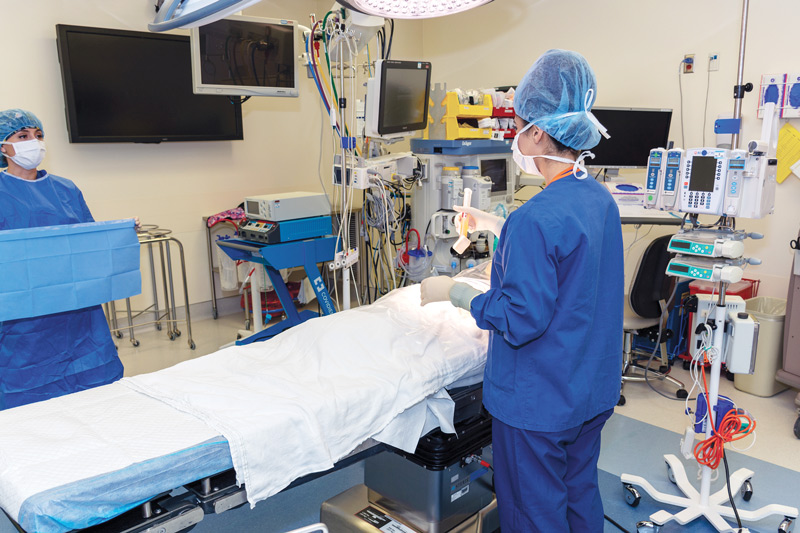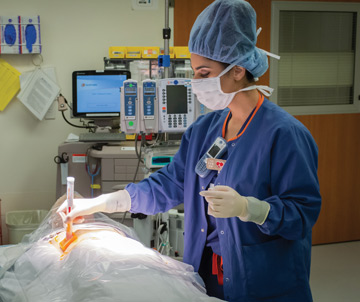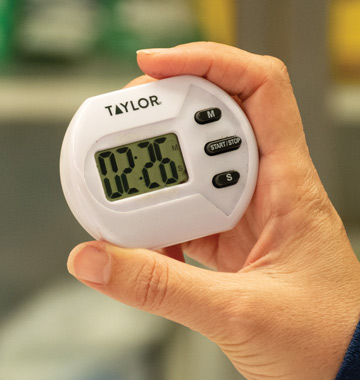Prepping the skin before surgery seems to be a simple matter. Apply the solution, let it dry and begin the operation with more confidence that the patient's surgical wound will emerge infection-free. But nationwide, experts say, prepping solution is applied correctly only about half the time. The best way to boost skin prep compliance is to focus on educating surgical team members about proper application techniques, standardizing the solutions you use and the process you've developed, and changing the culture in your ORs.
- Home
- Article
Are You Applying Skin Preps Properly?
By: Romulo Vallejo
Published: 2/11/2020
Address common reasons for noncompliance to reduce the risk of surgical site infections.

In May 2018, we decided to take a proactive approach to improving our skin prep compliance rate. We audited 31 cases over a three-day period in order to establish our compliance baseline. To ensure an unbiased audit, we announced that we'd be observing OR practice in general, not skin prep in particular. We found our team adhered to manufacturers' IFUs for skin prep application in 45% of the cases, while meeting the dry time standard of three minutes in 52% of the cases. That was consistent with national benchmarks, but we wanted to exceed the national average. First, though, we needed to identify specific opportunities for improvement.
- Knowledge deficits. We recognized that staff members weren't clear on how long application of the prep should be, and the length of dry time for each. We had an opportunity to remind clinicians of the need for and purpose of proper skin prepping as a best practice in the effort to protect against SSIs.
- Multiple solutions. Before we started this project, we typically used three different skin prep agents. While all were effective, our OR nurses and techs were switching among the three depending on individual surgeon preferences, a lack of standardization that led to confusion regarding how each solution should be properly applied. To reduce that knowledge deficit and simplify our practice, we decided to standardize on a single skin prep solution for all of our surgeries, and educate staff members on its proper use.
There was also a lack of standardization in terms of who was prepping the patient. Sometimes it was a nurse; other times it was the surgeon.
- Inadequate dry time. We have clocks in the OR, but staffers weren't always watching them to ensure prepping solutions had been allowed enough time to dry before drapes were applied. In some cases, a staff member was keeping time, but wasn't communicating it to the rest of the team. The scrub tech would start draping before the required dry time was observed.

Armed with that information, we set about on standardizing our skin prep process in order to increase our rates of compliance. Here's what we did:
- Settled on one solution. We went with the skin prep solution that most of our surgeons were already using, and about which they'd expressed a preference. Two surgeons were holdouts for a different prep, however, which was fine: We educated them on the use of that prep. For everyone else, we partnered with the vendor and provided education on the solution's proper use according to the manufacturer's IFU.
- Added timers. We all know time is of the essence in an OR; we want to provide excellent care and then turn that room over quickly for the next case. In order to ensure our OR staff adhered to the recommended prep dry times, we implemented small digital timers in each OR. They're kept at the nurse's prep stand, and staff members know to use them to ensure prepping solutions sit for the required three minutes before drapes are applied.
- Standardized the process. Developing and implementing a timeline algorithm that explicitly spells out our skin prep process helped formalize the practice. This plan delineates roles to the individual nurses and techs. The nurse (or the surgeon if that's the surgeon's preference, as is the case with one of our neurosurgeons) applies the prep according to the IFU, while also adhering to AORN guidelines by covering their arms. Once they properly prep the patient, the nurse hits the start button on the timer, and the three-minute prep drying countdown begins. When the timer beeps, that's the scrub tech's cue to drape the patient. By using this system, the whole group is aware of the three minutes of dry time. To ensure everyone knew their roles, we created prep charts that map out who's responsible for what. We also updated the surgeons' preference cards to include our algorithm.
- Encouraged feedback. We tasked our circulating nurse with taking ownership of the prepping process, but we also encouraged everyone in the OR to speak up if they witnessed noncompliance. Every person in the OR is ultimately responsible for the safety of the patient and to prevent SSIs as best they can by adhering to best practice.
- Followed up on noncompliance. When we learned of a breach in process, we reminded team member involved of our standard process. These reminders aren't punitive; they're meant to be constructive and informative. Conversely, we feel it's important to reinforce positive behavior. During huddles, we encourage leaders to recognize staff members who apply prepping solutions correctly and follow dry-time compliance.

With our program in place for several months, we performed another observational audit in January 2019 to evaluate its effectiveness. We still saw opportunity for improvement, and continued to partner and communicate with the correct stakeholders. We realized everyone in the OR needed to be fully engaged, involved and made aware of our prepping protocols.
While developing our new prepping process, we'd presented to the hospital's OR committee, which is the forum for all of our surgeons, so we went back to that group when more members were present. We also engaged our SSI and infection prevention teams. More surgeons were engaged with our refinements made to the standardization process as a result.
In December 2019, we audited again and saw a more significant increase in compliance. We were up to 68% in prep time compliance and 72% in dry time compliance. Subsequent findings have shown that we are holding steady at these new rates. We've now exceeded the national benchmark, but our goal is to further improve. Our SSI rates have, over the same time period, decreased, but it's unclear if that decline correlates with our improved skin prepping compliance.
Moving forward, we will conduct formal audits every six months to see how we're doing, but our commitment to raising skin prep and dry time compliance rates is always top of mind. Our system is working, but we can't settle for "good enough" where SSIs are concerned. The key to our success is to keep hammering our best practice protocol for skin prep home by reeducating, tracking compliance and reinforcing our process on an ongoing basis. OSM
.svg?sfvrsn=be606e78_3)
.svg?sfvrsn=56b2f850_5)